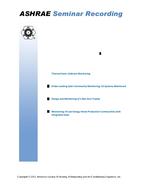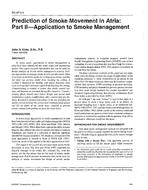The operation and performance of a thermal comfort controller for HVAC systems with forced-air ventilators were analyzed with the aid of a dynamic computer program. The functions and features of GEMS (Generalized Engineering Modeling and Simulation), a dynamic modeling and simulation software tool, are briefly described. Using GEMS, the effects of different ventilation airflow rates and sensible and latent efficiencies on the thermal comfort environment within the conditioned space were analyzed for Miami, Florida. The simulations indicate that when using a conventional thermostat, any form of mechanical ventilation will increase the moisture content of the air within a conditioned space in a cooling-dominated hot and humid climate. Therefore, while providing “fresh” outdoor air, mechanical ventilators in HVAC systems with conventional controllers may be a contributing factor to indoor air quality problems associated with high levels of moisture within a conditioned space. With conventional thermostats, occupants typically resort to undesirable and inefficient interventions (e.g., manually lowering the space dry-bulb temperature set point to “sweat out” the water from the air). Thus, there is a need for a method to control both the dry-bulb temperature and the moisture content within the conditioned space. The Auctioneering Temperature and Humidity Controller (ATHC) fulfills this need. These new algorithms were exercised for an HVAC system with mechanical ventilation. Simulation results from typical-day analysis and results from annual cooling operation are presented for Miami, Florida. When compared to results for systems with a conventional dry-bulb temperature controller, these results, consisting of annual cooling energy requirements, predictive mean vote (PMV) in the conditioned space, and so on, validate the superior thermal comfort provided by the auctioneering controller.
Authors: Dipak J. Shah
Citation: Thermal Performance of the Exterior Envelopes of Buildings VIII
Keywords: December, Florida, 2001
Citation: Thermal Performance of the Exterior Envelopes of Whole Buildings VIII
Product Details
- Published:
- 2001
- File Size:
- 1 file , 500 KB
- Product Code(s):
- D-8038


